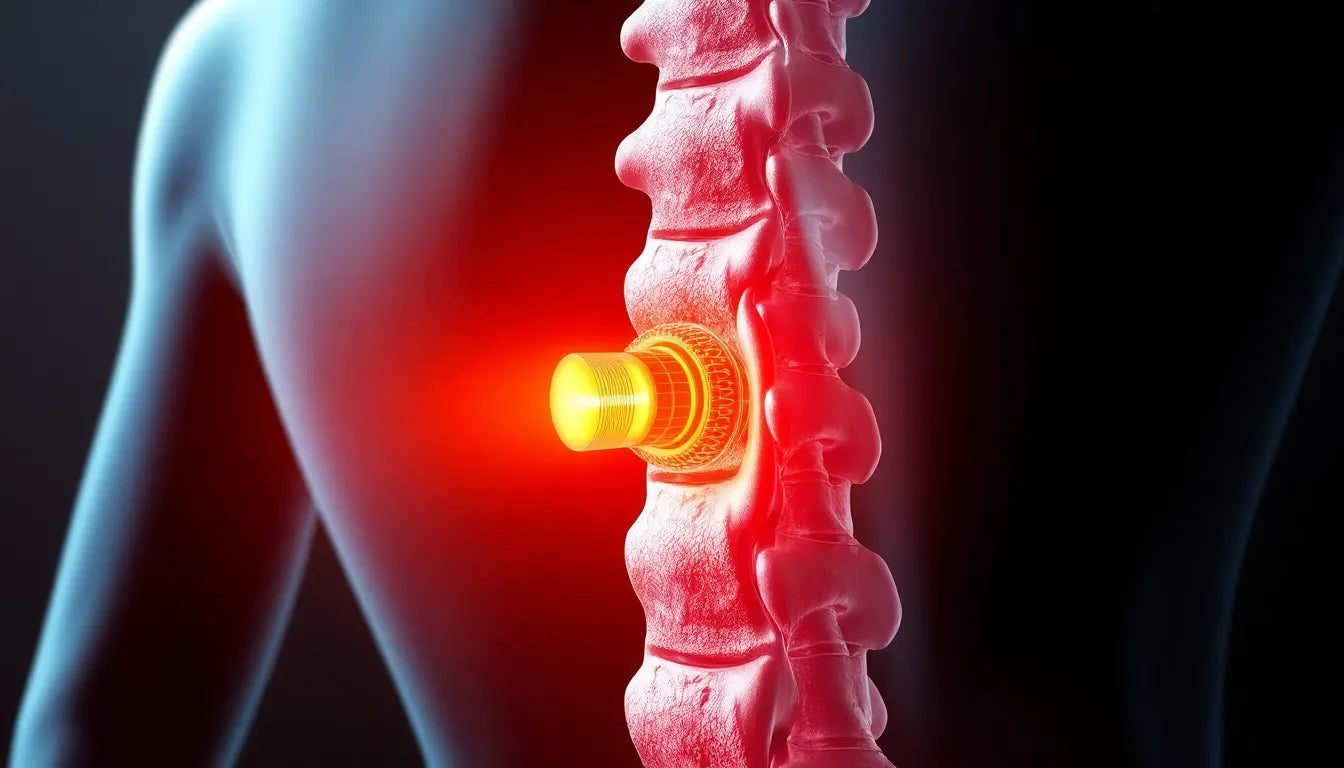Have you ever experienced an unexpected tingling sensation in your hands or feet and wondered what might be causing it? For many, this peculiar sensation can be both puzzling and concerning, especially when it seems to arise without any apparent reason. Interestingly, one potential culprit could be a herniated disc, a condition that might not immediately come to mind when considering symptoms in the extremities. This mysterious connection between a herniated disc and tingling in hands and feet is often overlooked, yet it holds significant implications for those affected.
Understanding the impact of a herniated disc on nerve function
A herniated disc occurs when the soft inner gel of a spinal disc pushes through a crack in the tougher exterior casing. This protrusion can press against nearby nerves, leading to a variety of symptoms depending on the location of the herniation. While back pain is a well-known symptom, the potential for nerve compression can lead to a cascade of other effects, including tingling sensations in the hands and feet. These symptoms can be particularly perplexing, as they may not seem directly related to the spine at first glance.
When a disc herniates in the cervical spine, or neck area, it can compress nerves that travel into the shoulders, arms, and hands. This often results in symptoms such as numbness, tingling, and even weakness in the hands and fingers. Similarly, a herniated disc in the lumbar spine, or lower back, can affect nerves leading to the legs and feet, causing pain, numbness, and tingling often associated with sciatica. The diverse range of symptoms that can arise from different spinal regions makes understanding this condition all the more important.
Purpose of exploring the herniated disc-tingling connection
The aim of this blog post is to shed light on the reasons behind the tingling sensations caused by a herniated disc and to provide a comprehensive understanding for those experiencing these symptoms. By delving into the mechanics of how a herniated disc can affect nerve function, we hope to demystify the condition and offer valuable insights into its impact on the body. Whether you're currently dealing with these symptoms or simply seeking to expand your knowledge, this post will equip you with the information needed to better understand the link between herniated discs and tingling in the extremities.
As we continue to explore this topic, we'll delve deeper into the specifics of herniated discs, examining how different locations within the spine can lead to varying symptoms in the hands and feet. By doing so, we'll uncover the intricate relationship between spinal health and nerve function, ultimately providing a clearer picture of how a herniated disc can manifest in unexpected ways.
Understanding herniated discs and their impact on nerves
A herniated disc, often referred to as a slipped or ruptured disc, occurs when the inner gel-like core of a spinal disc protrudes through the outer layer. This condition is most commonly seen in the cervical (neck) and lumbar (lower back) regions of the spine. To comprehend its effects, it's crucial to understand the anatomy of the spine. The spine is composed of vertebrae cushioned by discs that act as shock absorbers, allowing flexibility and movement. These discs play a vital role in maintaining spinal health and protecting the nerves that branch out from the spinal cord.
Cervical herniated discs and upper extremity symptoms
When a herniated disc occurs in the cervical spine, the nerves that extend into the shoulders, arms, and hands can become compressed. This compression can lead to a range of symptoms, including numbness, tingling, and weakness in the upper extremities. A key nerve root involved in these symptoms is the C8 nerve root, located between the seventh cervical vertebra and the first thoracic vertebra. Compression of this nerve root can cause tingling and numbness extending from the triceps down to the fingers, particularly affecting the middle and back of the hand. Additionally, individuals may experience a decrease in grip strength, making everyday tasks challenging.
Visualizing the cervical spine and its associated nerve pathways can help in understanding how these symptoms arise. A diagram illustrating the cervical spine and nerve roots can be a valuable tool for those seeking to grasp the complex relationship between spinal health and nerve function.
Lumbar herniated discs and lower extremity symptoms
In contrast, lumbar herniated discs affect the lower back and can lead to symptoms in the legs and feet. The lumbar spine is responsible for supporting much of the body's weight and is therefore susceptible to herniation. When a disc herniates in this region, it can impact the nerve roots between L4 and S3, leading to a condition known as sciatica. Sciatica is characterized by pain, numbness, and tingling that radiates from the lower back down the leg and into the foot. This condition can significantly impact mobility and quality of life, as the tingling and pain can be persistent and debilitating.
A chart comparing the symptoms of cervical versus lumbar herniations can provide clarity for those experiencing these issues. While cervical herniations primarily affect the hands and arms, lumbar herniations are more likely to cause discomfort in the lower body.
Simultaneous symptoms and severe cases
Although it is less common, some individuals may experience simultaneous tingling in both the hands and feet. This can occur in cases of significant spinal cord compression, where multiple herniations or a large herniation compresses the spinal cord itself. Such severe cases can lead to symptoms in both the upper and lower extremities, highlighting the importance of early diagnosis and treatment. Understanding these possibilities underscores the need for comprehensive medical evaluation when these symptoms arise.
By exploring the intricate relationship between herniated discs and tingling in the extremities, we gain insight into the body's complex network of nerves and the critical role the spine plays in overall health. In the next section, we will delve into recovery and symptom improvement, providing practical tips for managing these symptoms and promoting healing.
Simultaneous symptoms and severe cases
While less common, experiencing tingling in both hands and feet simultaneously can occur due to significant spinal cord compression. This situation arises when multiple herniations or a particularly large herniation compresses the spinal cord, potentially affecting both the upper and lower extremities. Such severe cases underscore the importance of early diagnosis and intervention, as untreated spinal cord compression can lead to more serious complications. Understanding the potential for these simultaneous symptoms highlights the need for comprehensive medical evaluation when they arise.
Recovery and symptom improvement
Recovery from a herniated disc often involves a gradual reduction in symptoms, including the tingling sensations in the hands and feet. This improvement signifies healing, as inflammation decreases and pressure on the affected nerves alleviates. Several strategies can aid in managing symptoms and promoting recovery:
- Ergonomic adjustments: Implementing ergonomic solutions, such as proper posture and supportive equipment, can reduce strain on the spine and alleviate nerve pressure.
- Physical therapy: Engaging in physical therapy helps strengthen the muscles supporting the spine, improving flexibility and reducing the risk of further injury.
- Regular exercise: Maintaining a routine of low-impact exercises can enhance overall spinal health and support recovery.
- Healthy lifestyle choices: Maintaining a healthy weight and avoiding activities that strain the back can prevent further disc herniation and support the healing process.
These approaches, combined with medical guidance, can significantly improve recovery outcomes for those experiencing tingling due to a herniated disc.
Frequently Asked Questions
Can a herniated disc heal on its own?
Yes, many herniated discs can improve over time with non-surgical treatments such as rest, physical therapy, and medications. The body's natural healing processes can help reduce inflammation and alleviate pressure on the nerves.
What are the warning signs that require immediate medical attention?
Severe or worsening symptoms, especially if they affect both hands and feet, or are accompanied by loss of bladder or bowel control, require immediate medical attention. These signs may indicate significant spinal cord involvement.
How can ergonomic solutions help in managing symptoms?
Proper posture and supportive equipment can reduce strain on the spine, alleviating pressure on affected nerves. Ergonomic adjustments in work and home environments can significantly contribute to symptom management.
Is surgery always necessary for a herniated disc?
No, surgery is typically considered a last resort after exploring conservative treatments like physical therapy, medications, and lifestyle modifications. Many individuals experience significant improvement without surgical intervention.
What lifestyle changes can aid recovery from a herniated disc?
Regular exercise, maintaining a healthy weight, and avoiding activities that strain the back can support recovery. Incorporating a balanced diet and staying hydrated also contribute to overall spinal health.
Understanding the complex relationship between herniated discs and tingling in the extremities empowers individuals to seek appropriate care and make informed decisions about their health. By recognizing symptoms early and adopting a proactive approach to treatment, recovery and improved quality of life are achievable goals.
Sources
- CORE Orthopedics. "Understanding Herniated Discs: Symptoms and Treatment Options."
- Dr. Kevin Pauza. "Nerve Root Impingement and Herniated Discs."
- Discseel. "Herniated Discs: Causes of Tingling and Numbness."
- MoreGoodDays. "Recovery from Herniated Discs: What to Expect."
- Spine-health. "Lumbar Herniated Disc Symptoms and Treatment."


















